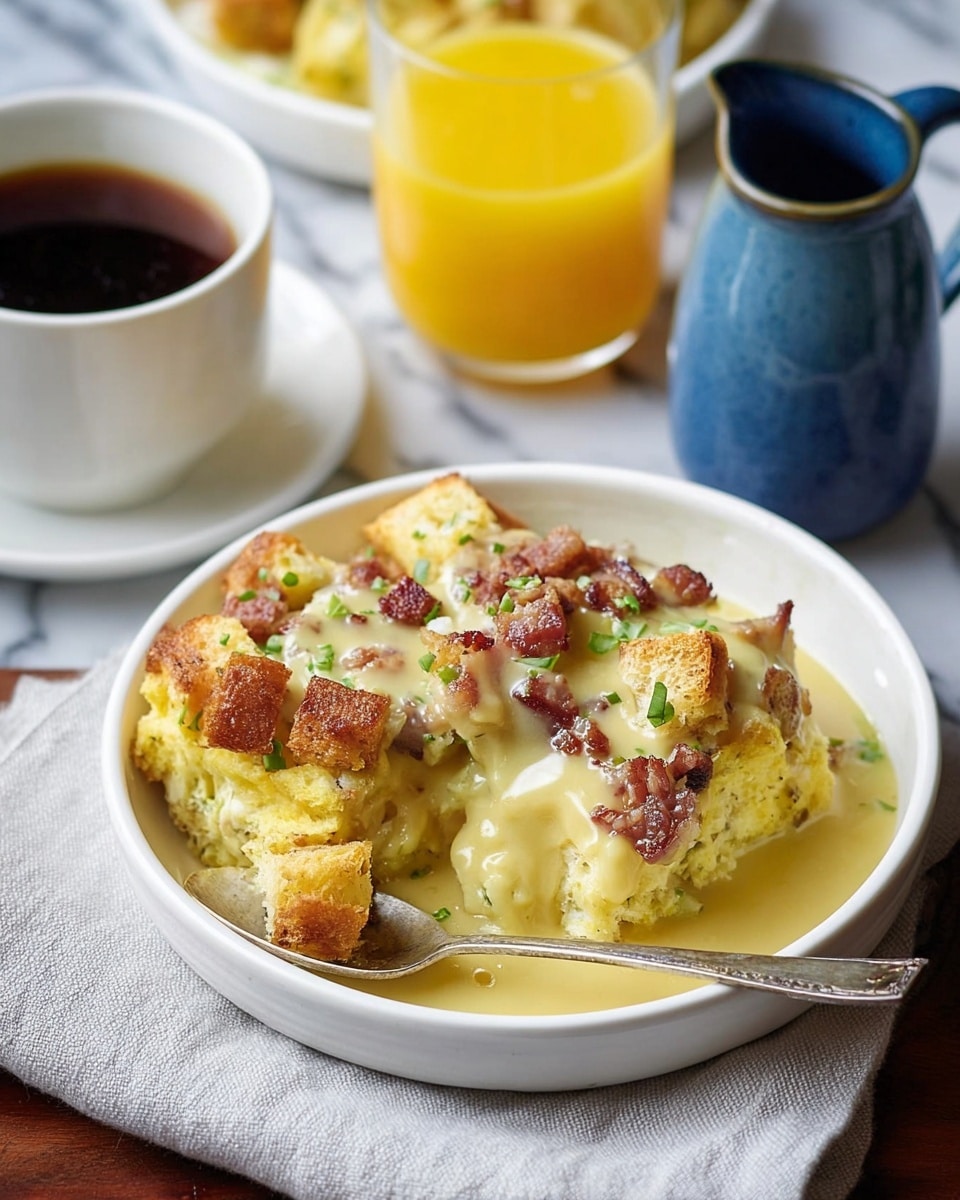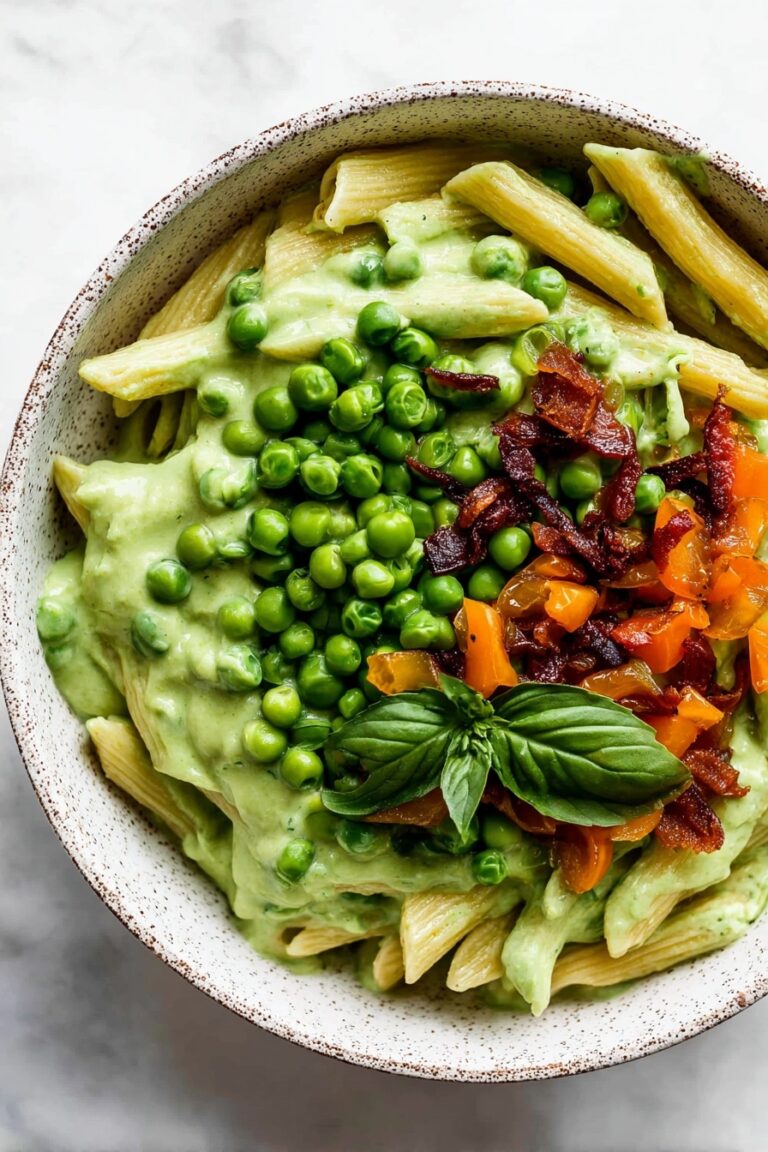Overnight Eggs Benedict Casserole Recipe
If you love the classic flavors of Eggs Benedict but want something that’s ready to go when morning rolls around, this Overnight Eggs Benedict Casserole Recipe is a game-changer. I first tried it on a busy weekend when I wanted a brunch-worthy dish without standing over the stove, and honestly, it quickly became my go-to for holidays and sleepy Sunday mornings. Trust me, waking up to the savory scent of Canadian bacon mingling with custardy eggs is pure magic.
This casserole is not just delicious but incredibly practical—you assemble it the night before, pop it into the fridge, and then bake it fresh the next day. The overnight soak really lets the eggs and bread soak up all those lovely flavors, creating a melt-in-your-mouth texture that’s hard to beat. Plus, topping it with a fresh, homemade hollandaise sauce feels fancy but is surprisingly straightforward. You’ll enjoy this Overnight Eggs Benedict Casserole Recipe whether you’re feeding a crowd or just treating yourself.
Why This Recipe Works
- Overnight Prep: Letting the casserole rest overnight allows the bread to absorb the egg mixture fully, resulting in a perfect custard-like texture.
- Rich, Homemade Hollandaise: The fresh sauce adds that signature Eggs Benedict tang and richness that store-bought just can’t match.
- Easy to Feed a Crowd: This recipe scales up effortlessly for brunches or family gatherings without extra stress.
- Flexible Ingredients: You can easily swap ham or Canadian bacon to suit your taste or dietary needs.
Ingredients & Why They Work
This Overnight Eggs Benedict Casserole Recipe relies on simple, quality ingredients that come together beautifully—the bread and eggs create the comforting base, while the Canadian bacon adds savory depth and saltiness. Whole milk gives creaminess without weighing it down, and the fresh lemon juice in the hollandaise brightens the whole dish.
- English muffins: Their sturdy, slightly chewy texture holds up well to soaking without turning mushy.
- Canadian bacon or ham: Adds smoky, meaty flavor essential for that classic Eggs Benedict profile. If yours isn’t cooked, make sure to cook it first.
- Eggs: The star of the show, eggs provide richness and set into a lovely custard when baked.
- Milk: Whole milk works best here for creaminess; lighter milks can make it less decadent.
- Butter: For the hollandaise, unsalted butter lets you control the salt and ensures a silky sauce.
- Lemon juice: Freshly squeezed for zing and balance against the rich butter and eggs.
- Salt and pepper: To season both the casserole and sauce, bringing out all the flavors.
- Chives: A fresh, mild onion note for garnish that brightens the dish visually and on the palate.
Make It Your Way
One thing I love about this Overnight Eggs Benedict Casserole Recipe is how easy it is to tweak it just the way you like. Whether you’re a fan of extra cheese, want to sub in turkey bacon for a leaner twist, or make it vegetarian with spinach and mushrooms, this recipe is forgiving and perfect for your personal touch.
- Variation: I often add a handful of shredded sharp cheddar or gruyère to the egg mixture for extra melty indulgence.
- Dietary tweaks: Swap dairy milk with oat or almond milk and use tofu scramble for a dairy-free, vegetarian-friendly version.
- Seasonal changes: Toss in some sautéed asparagus tips or sun-dried tomatoes in spring and summer for fresh flavor.
Step-by-Step: How I Make Overnight Eggs Benedict Casserole Recipe
Step 1: Prep the Bread and Meat Cubes
First, I spray my 9 x 13 inch pan with non-stick spray to keep everything from sticking and make cleanup easier. Then, I split the English muffins into halves and cut them into roughly half-inch cubes, which ensures they soak up the egg custard well without turning to mush. Next, I cube my Canadian bacon, using about half to mix in with the muffins. I love tossing these together gently with my hands, making sure everything is evenly distributed for consistent flavor in every bite.
Step 2: Whisk the Egg Mixture
In a large bowl, whisk together 10 eggs, 1 cup of whole milk, salt, and pepper until smooth. This part is quick but important—you want the seasoning well distributed for a balanced casserole. I usually whisk just until combined to avoid over-mixing, which can make the eggs tough.
Step 3: Assemble and Refrigerate Overnight
Pour the egg mixture evenly over the bread and Canadian bacon cubes in the casserole dish. Then top with the remaining meat cubes, pressing them lightly into the egg mixture to make sure they’re submerged. Cover the dish tightly with foil or plastic wrap and pop it in the fridge overnight or up to 24 hours. Letting it sit lets the flavors meld and the bread soak perfectly—don’t skip this step unless you’re in a hurry!
Step 4: Baking Time
When you’re ready to bake, pull the casserole out around 90 minutes ahead to take the chill off. Preheat your oven to 350°F (175°C). Remove the cover and bake for 50 minutes to an hour, covering loosely with foil for the last 20 minutes to prevent too much browning on top. You’ll know it’s done when the eggs are set and a knife inserted in the middle comes out clean.
Step 5: Whip Up the Hollandaise Sauce
While the casserole bakes, I make the hollandaise fresh—it really makes all the difference. Melt your unsalted butter and keep it warm. In a blender, combine egg yolks, fresh lemon juice, salt, and a touch of hot sauce or cayenne for that subtle kick. Blend briefly, then slowly stream in the warm butter while blending on low until the sauce thickens to silky perfection. It’s best served immediately because as it cools, it firms up, but you can keep it warm in a thermos or on very low heat until ready.
Tips from My Kitchen
- Room Temperature Eggs: Letting the casserole sit on the counter before baking helps it cook more evenly from edge to center.
- Avoid Soggy Bread: Using English muffins instead of softer bread means the cubes hold their structure, even soaked in egg.
- Slow Butter Addition: Pouring melted butter slowly into the blender ensures your hollandaise emulsifies beautifully—be patient!
- Cover Carefully: Using loose foil in the last 20 minutes stops over-browning while letting the casserole finish cooking through.
How to Serve Overnight Eggs Benedict Casserole Recipe

Garnishes
I love finishing this casserole with a sprinkle of fresh chives—they add a bright color pop and a mild onion flavor that perfectly balances the richness. Sometimes, I’ll also add a little smoked paprika or a few cracked peppercorns on top for that extra touch. It’s those simple garnishes that take the dish from great to memorable.
Side Dishes
This casserole pairs wonderfully with light, fresh sides like mixed greens tossed with lemon vinaigrette or a simple fruit salad—think juicy berries or sliced melon. For a heartier brunch, roasted breakfast potatoes or grilled asparagus also complement the creamy eggs and savory bacon perfectly.
Creative Ways to Present
For special occasions, I sometimes serve this casserole in individual ramekins right out of the oven, topped with a drizzle of hollandaise and a sprinkle of herbs. It looks elegant and helps guests get just the right portion. Another fun idea: use mini English muffins and bake in a muffin tin for perfect single-serve bites—great for parties or brunch buffets.
Make Ahead and Storage
Storing Leftovers
I keep leftover casserole covered tightly in the fridge for up to three days, and it reheats beautifully when warmed gently in the oven or microwave. The texture softens a bit with storage, but the flavors stay rich and comforting — perfect for a quick weekday breakfast or lunch.
Freezing
While I haven’t officially frozen the whole casserole, I’ve had success freezing individual portions after baking. Just cool completely, wrap tightly in plastic, and freeze for up to a month. Reheat covered in the oven to keep moisture locked in. The hollandaise is best fresh but can be made on the spot afterward or skipped if preferred.
Reheating
When reheating leftovers, I recommend using a low oven (about 300°F) and covering the casserole with foil to prevent drying out. Heat for 15-20 minutes until warmed through. You can quickly revive the hollandaise by gently warming it on the stove or in a thermos, stirring occasionally to keep it smooth.
FAQs
-
Can I make the Overnight Eggs Benedict Casserole Recipe without Canadian bacon?
Absolutely! You can substitute with ham, regular bacon (cooked and chopped), or even sausage for a different flavor profile. For a vegetarian option, skip the meat altogether and add sautéed veggies like spinach or mushrooms.
-
Is it okay to bake the casserole immediately without letting it sit overnight?
You can bake it right away if you’re short on time, but the texture won’t be quite as custardy. Letting it soak overnight helps the bread soften fully and develop richer flavor, so plan ahead when you can for the best results.
-
How do I know when the hollandaise sauce is ready?
The sauce will thicken and become creamy as you slowly blend melted butter into the egg yolk and lemon juice mixture. It should coat the back of a spoon without being runny or breaking. If it’s too thick, add a teaspoon of warm water to smooth it out gently.
-
Can I prepare the hollandaise sauce in advance?
I recommend making hollandaise right before serving since it tends to thicken and separate as it cools. If you need to prepare early, keep it warm in a thermos or gently reheat over very low heat, stirring constantly to avoid curdling.
-
What can I serve with this casserole for a complete brunch?
Try pairing it with fresh fruit salad, mixed greens with a light vinaigrette, or roasted potatoes for a hearty and balanced meal. Mimosas or your favorite coffee also make excellent companions.
Final Thoughts
The Overnight Eggs Benedict Casserole Recipe has become my cherished brunch secret because it’s effortless to prep, delivers incredible flavor, and always impresses guests without the stress of making classic eggs bennie from scratch in the moment. I love that I can customize it easily while still serving up that traditional hollandaise goodness. Give it a try—you’ll feel like you waltzed right into a fancy brunch spot without leaving your kitchen!
Print
Overnight Eggs Benedict Casserole Recipe
- Prep Time: 20 minutes
- Cook Time: 1 hour
- Total Time: 1 hour 20 minutes
- Yield: 9 servings
- Category: Breakfast
- Method: Baking
- Cuisine: American
- Diet: Low Lactose
Description
A delicious and comforting Overnight Eggs Benedict Casserole featuring cubes of English muffins and Canadian bacon baked in a savory egg mixture, topped with a rich homemade hollandaise sauce. Perfect for brunch gatherings or special mornings, this make-ahead casserole is easy to prepare and yields tender, flavorful slices ready to serve.
Ingredients
For the Casserole
- 6 whole English muffins
- 450 grams (1 pound) thick cut Canadian bacon or ham
- 10 large whole eggs
- 227 grams (1 cup, 240 milliliters) milk, preferably whole milk
- 1 teaspoon salt
- 3/4 teaspoon black pepper
- Chives for garnish if desired
For the Hollandaise
- 170 grams (1 1/2 sticks, 3/4 cup) unsalted butter
- 6 large egg yolks
- 38 grams (2 1/2 tablespoons) fresh lemon juice
- 1/2 teaspoon salt
- Splash of hot sauce or pinch of ground cayenne, if desired
Instructions
- Prepare the casserole dish – Spray a 9 x 13 inch (22 x 33 cm) baking dish with non-stick cooking spray to prevent sticking.
- Cube the bread – Split the English muffins in half, then cut into ½ inch (1.25 cm) cubes. Place these cubes evenly in the bottom of the prepared baking dish.
- Add Canadian bacon – Cube the Canadian bacon or ham and scatter half the cubes over the bread. Toss gently by hand to combine the cubes of bread and meat, then spread evenly in the dish.
- Mix eggs and milk – In a large bowl, whisk together the eggs, milk, salt, and black pepper until fully combined and smooth.
- Assemble casserole – Pour the egg mixture over the bread and meat in the baking dish. Top with the remaining Canadian bacon cubes and press gently to submerge the meat in the egg mixture.
- Refrigerate overnight – Cover the dish tightly with foil or plastic wrap and refrigerate overnight or up to 24 hours. This step can be skipped, but resting improves texture.
- Bring to room temperature – About 1 hour 30 minutes before baking, remove the casserole from the fridge and let it sit at room temperature for 30 minutes.
- Preheat oven – Set the oven to 350°F (175°C) to preheat.
- Bake the casserole – Remove cover and bake for 1 hour until eggs are set. Protect the top with loose foil during the final 20 minutes to prevent over-browning. Once done, keep the casserole covered until serving.
- Make hollandaise sauce – Melt the butter and keep warm. In a blender, combine egg yolks, lemon juice, salt, and hot sauce or cayenne if using; blend for a few seconds. Blend again on low while slowly streaming in the melted butter to thicken the sauce. Adjust seasoning to taste.
- Serve – Slice the casserole and pour hollandaise sauce over each serving. Garnish with chives if desired. Serve immediately for best texture.
- Store leftovers – Cover and refrigerate any leftovers for up to 3 days.
Notes
- If your Canadian bacon is not precooked (common outside the US), cook it before adding to the casserole to ensure food safety.
- Letting the casserole rest overnight improves texture and flavor development.
- Keep hollandaise warm in a thermos or on a low heat source to prevent it from solidifying before serving.
- Use whole milk for a richer texture, but 2% milk can be substituted to reduce fat.
- The casserole can be baked immediately, but resting is recommended.
- Use fresh lemon juice for the hollandaise sauce for best flavor.
Nutrition
- Serving Size: 1 slice (approximate)
- Calories: 370 kcal
- Sugar: 2 g
- Sodium: 680 mg
- Fat: 25 g
- Saturated Fat: 12 g
- Unsaturated Fat: 11 g
- Trans Fat: 0.5 g
- Carbohydrates: 17 g
- Fiber: 1 g
- Protein: 18 g
- Cholesterol: 310 mg









